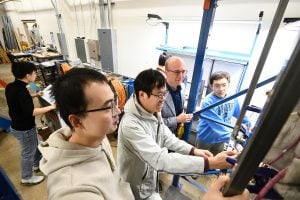Thomas Gernay, an associate professor in civil and systems engineering, develops innovative methods to advance resilience of the built environment against fire. He is also a member of ROSEI. His pioneering computational modeling techniques and risk-based methodologies, which are used worldwide, are helping structural engineers, architects, and decision-makers create buildings that are better able to withstand fire and other man-made and natural threats.
Gernay founded and leads Johns Hopkins’ Multi-Hazard Resilient Structures research group. Combining computational mechanics, experimental testing, performance-based design, and the development of numerical analysis software, his team seeks to enhance the resiliency of structures through the development of computer simulations that model the performance of entire buildings under extreme hazards. In particular, he has an interest and noted expertise in studying the effects of fire and multi-hazard scenarios involving a fire on materials, structures, and systems.
Gernay is the co-author of SAFIR®, an innovative software used by more than 300 institutions, engineers, and researchers worldwide to model accurately and predict a structure’s response to fire. The SAFIR software was used by three of the leading structural engineering firms working on an American Society of Civil Engineers Structural Engineering Institute project on advancing performance-based structural fire design in the U.S. His lab also studies the impact of critical infrastructure damage, which can disrupt a city’s ability to function, and develops methods to minimize damage and recovery time to enhance community resiliency. He is interested in the advancement of building codes and the cost-benefit assessment of structural designs and safety investments. He is a primary author for the new fire appendix in the American Iron and Steel Institute’s S100 cold-formed steel standard and convenes the Performance-based Fire Design working group for the International Federation for Structural Concrete.
His research has been funded by the National Science Foundation, National Institute of Standards and Technology, the American Concrete Institute, the American Iron and Steel Institute, the National Fire Protection Association, and others.
Gernay was recognized as the 2025 Outstanding Educator of the Year from the Maryland Section of the American Society of Civil Engineers. He also earned a NSF Early CAREER Award, the International Association of Fire Safety Science’s Magnusson Award, and the American Institute of Steel Construction’s Terry Peshia Early Career Faculty Award—all in 2023. A fellow of the Hopkins Extreme Materials Institute, he received a 2019 HEMI Seed Grant for his experimental study of metals under extreme temperatures. He also received the 2019 Foundation Medal from the NFPA Fire Protection Research Foundation. Other professional awards include the International Gustave Magnel Award (2017) and the IAFSS Best Thesis Award (2014) for his contributions to the modeling of concrete at elevated temperature, as well as the McKinsey & Company Scientific Award (2013). He received fellowships from the Belgian National Fund for Scientific Research, the Belgian American Education Foundation, and the Fulbright Commission. Prior to joining the Johns Hopkins faculty in 2018, Gernay was an adjunct lecturer at the University of Liege in his native Belgium.
He is a member of the American Society of Civil Engineers and served on the steering committee of the ASCE Structural Engineering Institute’s Technical Committee on Fire Protection. He also serves as a Voting Member on the Fire Resistance and Fire Protection Committee for the American Concrete Institute and as Vice Chair on the Thin-Walled Structures task group for the Structural Stability Research Council. His expertise contributed to the revision of Annex C of Eurocode 1992-1-2 for concrete columns in fire. In addition to authoring more than 150 articles in peer-reviewed journals and conference proceedings, Gernay has delivered invited lectures at multiple institutions and frequently presents courses on the SAFIR software.
Gernay is an associate editor of Fire Technology, the peer-reviewed journal of the National Fire Protection Association and the Society of Fire Protection Engineering. He reviews papers for numerous journals, among them Engineering Structures, Fire Safety Journal, and ASCE Journal of Structural Engineering. He is currently on the Steering Committee of the Structures in Fire Conference series and has served on the SiF scientific committee since the 10th edition in 2018. He served on the Engineering Mechanics Institute’s conference committee in 2022. Gernay served as an external committee member for PhD defenses in the US, Spain, France, Italy, Belgium, and the UK.
Gernay received his BSE (2007) and ME (2009) in civil engineering and his PhD (2012) in structural engineering from the University of Liege in Belgium. He conducted research at the CEA near Paris, France, was a project engineer for Cockerill Maintenance Ingenierie in Belgium, and performed post-doctoral work at Princeton University as a Fulbright Fellow.



